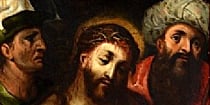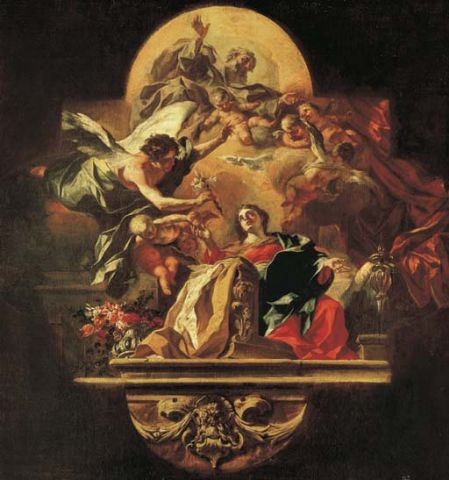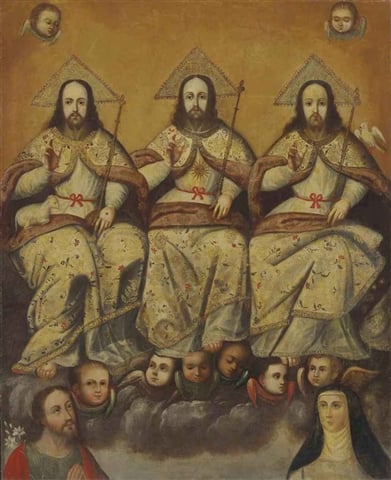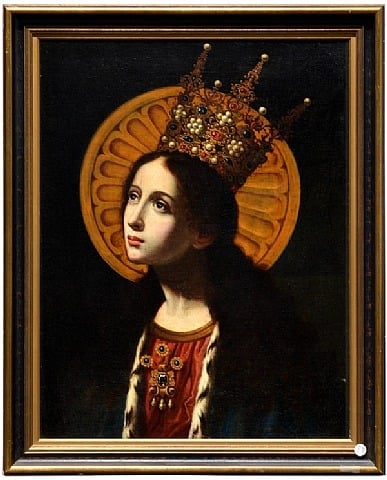Art & Exhibitions
Introduction to Medieval Iconography
Learn about medieval iconography and religious representation in the Middle Ages.

Learn about medieval iconography and religious representation in the Middle Ages.

Cyril Bourlier

In the art world, we are used to seeing the same representations of biblical figures. For that reason, we often believe that representations of the Holy Trinity follow internationally and unconditionally accepted conventions: God in Heaven, a dove descending toward Christ, and of course, Jesus, on the cross or being baptized. But the complexity of religious history and the multitude of interpretations that arise from a single event led to a wide range of representations of these biblical figures.
This article will provide you with an introduction to medieval iconography. Iconography is a science that focuses on the study of images, and medieval iconography is generally thought of as a reference to medieval Catholic iconography. This article will focus on the representations of God, the Holy Spirit, the Virgin Mary, and Christ, developed during the Middle Ages (from the 4th century to the 15th century).
Although this article is entitled Introduction to Medieval Iconography, you will notice that the images used are from the Renaissance period. The Renaissance is characterized by a clear rupture with the Middle Ages in terms of style, medium, and subject matter, among other things. But in terms of the way biblical events were represented, it remained the same and evolved from what was done during the Middle Ages. Moreover, the paintings I chose are particularly helpful in illustrating my points.
The Representation of God:
In the Old Testament, God never appears as a physical person. He is always implied through natural elements, such as a ray of light, fire, wind, etc. This representation is also seen in the New Testament, although far less frequently. Some paintings mimic this by representing God through natural elements, or else as a hand, always the right, which symbolized power in the Jewish and Hebraic traditions.
The first evocation of God in physical form occurs in Book Seven of Daniel, verse nine, when he describes God as an old man with a white bear, wearing white clothes, seated on a throne, surrounded by light.

Francesco Solimena, The Annunciation, c.17th–18th centuries, oil on canvas, sold at Christie’s New York
In the 14th and 15th centuries, God is usually represented as the Pope or Emperor both on Earth and in Heaven. When represented in this way, God is usually shown with the papal crown, an orb of the Earth, and a religious symbol, such as a cross.
God has also been depicted in a very similar manner as the Greek “father of the gods,” Zeus. Links between the Christian Church and ancient mythology were quite common, due to the fact that it was easier for the population to accept new forms of worship if those forms were based on something they already knew. Indeed, many events in the Christian calendar were set to coincide with major events from pagan culture.
The Representation of the Holy Spirit:
In the Old Testament, the Holy Spirit is portrayed as the spirit present during the Creation. In the New Testament, the Holy Spirit has an important role in the Annunciation, the baptism, and the Pentecost.
As shown in the painting above, the Holy Spirit is almost always depicted as a dove. The depiction of the Holy Spirit as a dove comes from Genesis, and appears again in the text of St. Matthew and St. Mark when they speak about the baptism of Christ.
However, the Holy Spirit can also appear as fire, or even as a man, although this is less commonly seen. In the case of the Holy Spirit taking on human form, God, the Holy Spirit, and Christ appear as three identical men. The Holy Spirit almost always holds the book, which is one of his attributes, Christ appears with the cross, and God with the orb of the Earth.

Anonymous, The Holy Trinity, late 17th or early 18th century (Cuzco School), oil on canvas, sold at Christie’s New York
The Holy Trinity, seen above, is an example of Christ, God, and the Holy Spirit represented as three identical men, identified based on their attributes. On the right, the dove indicates the Holy Spirit, on the left, the lamb and the stigmata indicate Jesus, and God is in the middle.
For the theme of the Transfiguration of Jesus—the moment when Jesus becomes radiant upon a mountain and speaks with the apparition of Moses and Elijah—the Holy Spirit is often represented as a radiant cloud.
The Holy Spirit is also represented with his seven gifts (wisdom, understanding, counsel, knowledge, fortitude, piety, and fear of the Lord). These gifts are symbolized by seven medallions, or seven jets of fire under the dove, and serve as a protector of humanity.
The Representation of the Virgin Mary:
Worship of the Virgin Mary began during the very early years of Christianity. However, there are only a few references to her in the Bible. Almost everything we know about Mary comes from apocryphal texts.
The Church often treats Mary as an access point for Jesus, and much of her importance derives from the significance of that role. More than half of the references to the Virgin come from legend, stories, or traditions, and we know very little about the specific events of her life, and those specifics are often linked to Jesus’s life: the Marriage at Cana, the Crucifixion, the Pentecost, etc. But nothing is known about her wedding, her youth, or what happens to her during Jesus’s public life. Then, after Jesus’s death, the Apocryphal texts depict her assumption.
She is frequently represented with a cape and tunic, often in blue and red. The blue represents her divinity, and is a symbol of heaven. The red represents the Earth, or blood, and is symbolic of humanity. Her head is covered as a sign of honesty. When her head is uncovered, it is to underline her virginity. Her image is meant to be ageless, and emphasize her divinity as well as her humanity.
In the early years of Christianity, Mary often resembled the female icons of older religions, including Isis, who was, among other things, the Ancient Egyptian goddess of motherhood.
One of Mary’s attributes is the globe. The globe is often symbolic of the Earth, but when depicted in a smaller form, symbolizes a fruit. In this way, Mary came to represent the new Eve, a sign of redemption. St. Thomas said “The fall came through one woman, but redemption came through another.”
Mary’s other attributes include a crown, which she has been associated with since the 12th century, and is emblematic of her position as “Queen of Heaven.”

Francesco Curradi, The Madonna and the Angel Gabriel, oil on canvas, c.17th century, The Art Collection, Inc., Great Neck, NY
When her coronation is depicted, she also holds a scepter, representative of her role as the protector of the Church (Christ is protector of the State). A scepter painted with a Fleur-de-lis symbolizes Mary’s chastity and purity.
The Representation of Jesus Christ:
Jesus is represented in many ways, some of which do not even involve the human form.
Indeed, several animals are used in medieval iconography to depict Jesus, or more specifically, one of Jesus’s characteristics. He can be symbolized by the fish, the dolphin, the eagle, the peacock, the lion, the deer, the ostrich, the pelican, the ant, the phoenix, the ram, and even the unicorn, which was banned during the Counter-Reformation in the 16th century.
The lamb appears in the Old and New Testaments. The lamb is symbolic of the Messiah, which in the Christian tradition is Jesus. The lamb is also associated with sacrifice, which corresponds to Jesus, who was sacrificed and later resurrected on earth.
The dolphin also symbolizes the death and resurrection of Jesus. The dolphin’s movements, swimming above and below the surface of the ocean, are symbolic of Jesus’s escape from shadow (death) and return to light (life). Moreover, water is also evocative of the idea of baptism: through baptism, the sinner dies and is reborn in the light of God.
The feathers of the peacock evoke the stars and the galaxy. In early Christian Art, the peacock is linked to the resurrection of Jesus and the immortality of the soul. The peacock sheds his feathers much like the soul leaves the body and embraces immortality. This symbol is often found on headstones.
In terms of his human appearance, two chronological movements established the rules about what Jesus looked like. Initially, because of the influence of the School of Alexandria, Christ was depicted as a Hellenistic man, meaning he was represented as Apollo, a handsome young man through whom the divinity shined. Christ was depicted that way until the 4th century.
Then, between the 4th and 6th century, this representation was challenged by the Syriac School, which was linked with the Aristotelian School, and who considered nature to be a reflection of God. According to them, Christ must have looked like any Christian living in Mesopotamia, but with a clearly divine aura. This is the image we still have of Jesus today.

Agostino Carracci, Ecce Homo, oil on copper, c.15th–16th centuries, The Art Collection, Inc., Great Neck, NY
This article is based on the class taught by Professor Matilde Azcárate Luxán, Department of Medieval Art, Universidad Complutense, Madrid, Spain.